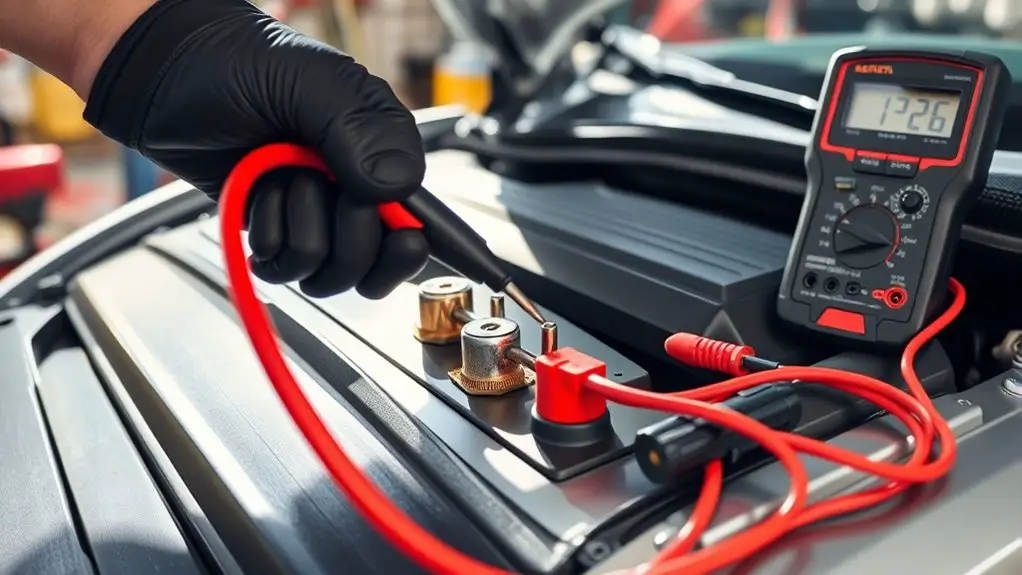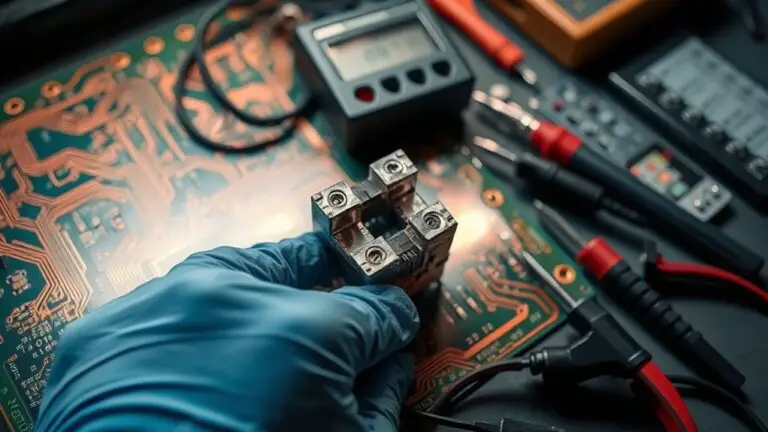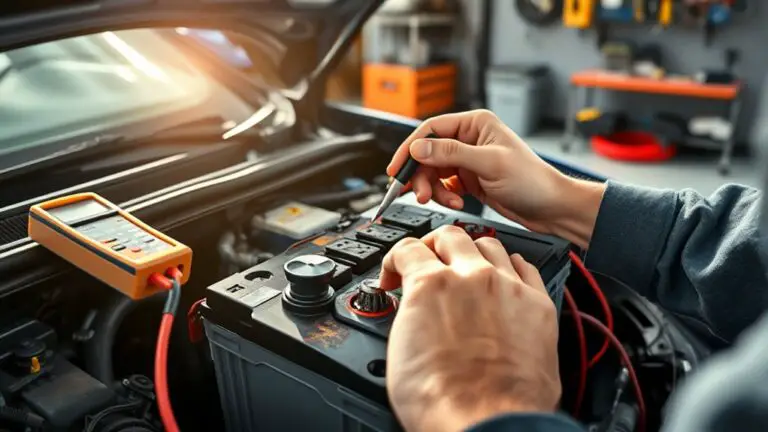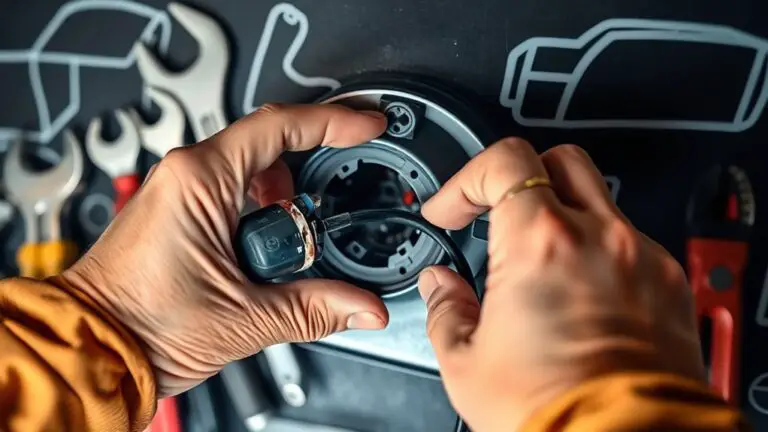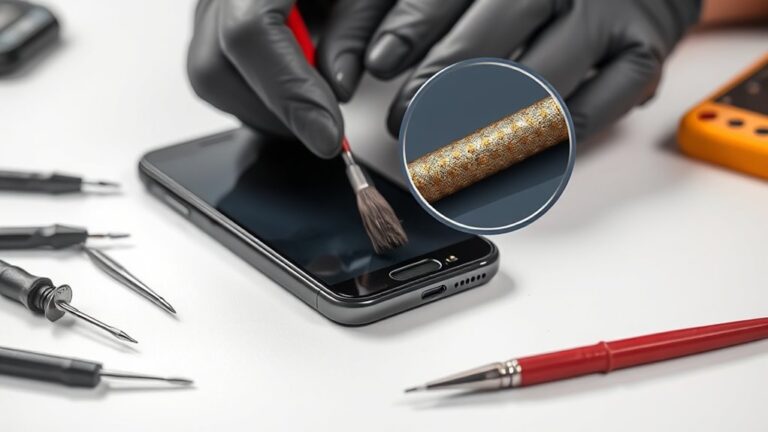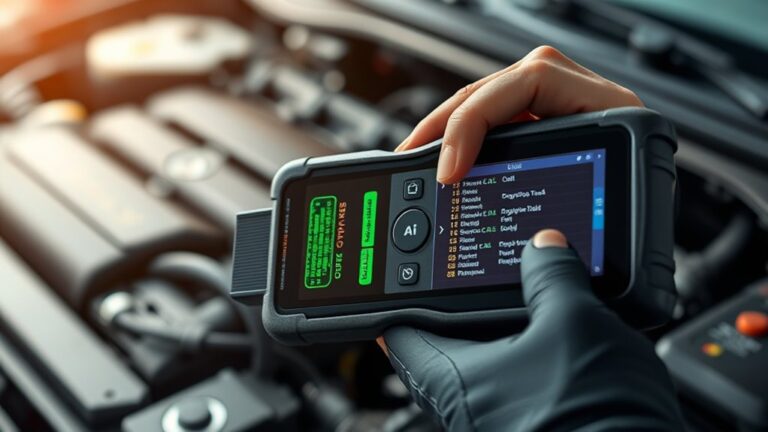How to Diagnose Dead Battery in Compact Car
To diagnose a dead battery in your compact car, first, look for symptoms like a battery warning light or clicking sounds when turning the key. Inspect battery connections for corrosion and make certain they’re tight. Use a multimeter to check the voltage—12.4 to 12.7 volts is healthy. If the battery’s weak or swollen, consider replacing it. Knowing these steps is essential to getting back on the road, and there’s more valuable information to discover on this topic.
Recognizing the Symptoms of a Dead Battery

Have you ever wondered how to tell if your car battery is dead? Recognizing the symptoms can save you time and frustration. One clear indicator is the battery warning light on your dashboard. If this light illuminates, it often signals potential electrical issues. When you turn the key, listen for a clicking sound instead of the engine cranking; this usually means the battery lacks sufficient power. Additionally, dim headlights or slow power window operation can signal a failing battery. If you experience these signs, don’t ignore them. A dead battery can leave you stranded, compromising your freedom and mobility. Another symptom is a foul smell; a swollen battery case might indicate leakage or corrosion, leading to further electrical issues. By staying vigilant and recognizing these symptoms early, you can address problems before they escalate, ensuring your vehicle remains reliable and ready for the road.
Checking Battery Connections and Terminals
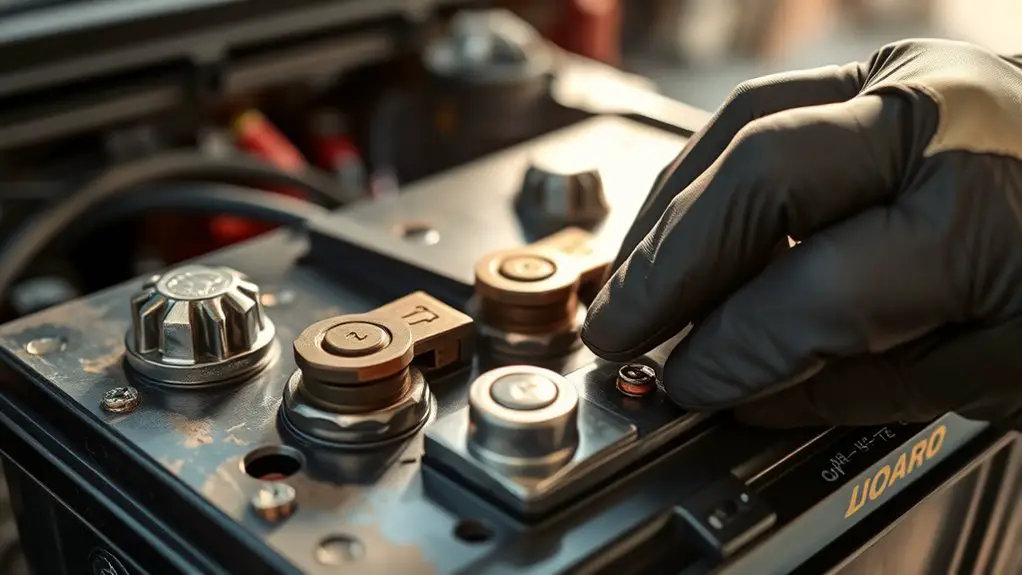
Before diving into more complex diagnostics, it’s crucial to check the battery connections and terminals, as loose or corroded connections can often mimic a dead battery. Start by inspecting connectors for any signs of corrosion or dirt. If you see any buildup, you’ll need to clean the terminals. Use a mixture of baking soda and water to neutralize the corrosion, applying it with a brush. Make sure you disconnect the battery cables before cleaning; always start with the negative terminal. After cleaning, rinse with water and dry the terminals thoroughly.
Next, check the tightness of the connections. Loose connections can lead to poor electrical contact, causing starting issues. Tighten any loose cables securely, but don’t over-tighten, as this could damage the terminals. Once you’ve cleaned the terminals and secured the connections, you’re ready to move on to the next step in diagnosing your battery issue.
Testing the Battery Voltage
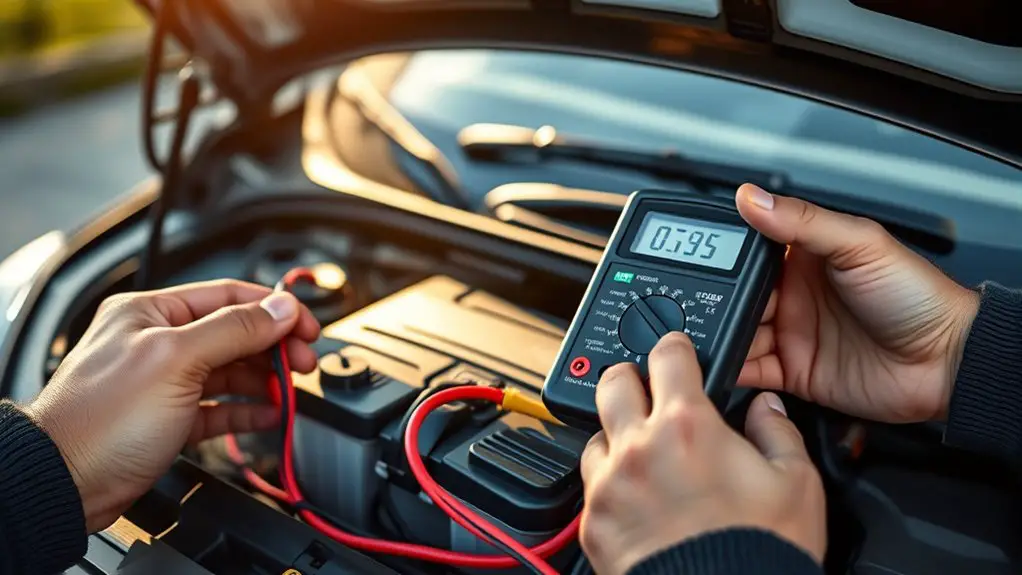
To determine if your battery is truly dead, testing the battery voltage is vital. Begin by gathering a digital multimeter, as it provides accurate readings. Set the multimeter to the DC voltage setting, ideally at a range of 20 volts. Next, connect the red probe to the positive terminal and the black probe to the negative terminal of your battery.
A healthy battery should show a voltage reading between 12.4 and 12.7 volts. If your multimeter readings fall below 12.0 volts, it indicates the battery is weak and may need charging. Readings below 11.8 volts typically suggest a dead battery.
Always verify your multimeter probes are securely attached during the test. This simple process can save you time and frustration, helping you decide if your battery needs replacement or simply a recharge. Understanding battery voltage is essential for maintaining your vehicle’s electrical system.
Jump-Starting Your Car
Jump-starting your car can be a straightforward solution when your battery fails to start the engine. To effectively execute jump starting techniques, you’ll need a set of jumper cables and a second vehicle with a functional battery. First, position both cars close enough for the cables to reach. Turn off all electronics in both vehicles. Connect one red clamp to your dead battery’s positive terminal and the other red clamp to the working battery’s positive terminal. Next, attach one black clamp to the working battery’s negative terminal and the other black clamp to an unpainted metal surface on your car to ground it. Start the functioning vehicle, allowing it to run for a few minutes before trying to start yours. Once your engine roars to life, carefully remove the cables in reverse order. Always keep emergency supplies handy to guarantee you’re prepared for unexpected situations.
When to Replace Your Battery
Knowing when to replace your battery is essential for maintaining your vehicle’s reliability. Most batteries have a lifespan of about 3 to 5 years. Here are some key replacement signs to watch for:
| Replacement Signs | Explanation | Action Needed |
|---|---|---|
| Slow Engine Crank | Engine cranks slowly on startup | Test the battery |
| Electrical Issues | Lights or electronics malfunction | Inspect and replace |
| Swollen Battery Case | Physical deformity of the battery | Replace immediately |
| Dashboard Warning Light | Battery warning indicator on dash | Visit a mechanic |
If you notice any of these signs, it’s time to think about a replacement. Proactive measures can prevent unexpected breakdowns, ensuring you maintain the freedom to drive wherever you desire. Regular checks and timely replacements will keep your compact car in ideal shape and ready for any adventure.
Frequently Asked Questions
Can a Dead Battery Cause Other Car Issues?
Yes, a dead battery can cause various car issues. You might notice battery symptoms like dim lights or the engine not starting. These problems can affect systems like your ignition and electrical components. Regular battery maintenance is vital to avoid such complications. If you’re experiencing issues, it’s important to check the battery first. Addressing battery-related problems promptly can prevent further damage to your vehicle and guarantee a smoother driving experience.
How Long Can a Car Sit Before the Battery Dies?
Picture your car parked under the warm sun, its engine silent. If you leave it sitting for about two weeks, the battery’s lifespan can start fading, especially if it’s older or weak. Regular car maintenance can help prolong its life, but even a good battery might struggle after prolonged inactivity. To avoid a dead battery, consider starting your car or using a trickle charger if you plan on leaving it untouched for a while.
Does Cold Weather Affect Battery Performance?
Yes, cold weather greatly affects battery performance. When temperatures drop, a battery’s chemical reactions slow down, reducing its ability to hold a charge. You might notice your car struggles to start or the battery’s capacity diminishes. In frigid conditions, it’s essential to make sure your battery’s in good shape; otherwise, you could face unexpected failures. Regular maintenance and checks can help you avoid the hassle of being stranded in the cold.
Can I Use a Multimeter to Test Battery Health?
Absolutely, you can use a multimeter to test battery health. Picture your battery as a lifeline for your car, pulsating with energy. By connecting the multimeter’s probes, you can assess voltage levels and determine if it’s holding a charge. When performing battery testing, aim for around 12.6 volts for a healthy battery. If it’s markedly lower, it might be time to contemplate a replacement, granting you the freedom to hit the road without worries.
What Safety Precautions Should I Take When Handling Batteries?
When handling batteries, you should wear protective gloves and safety goggles to prevent acid exposure. Make certain you’re in a well-ventilated area to avoid inhaling fumes. Always disconnect the battery terminals carefully, starting with the negative. For battery disposal, follow local regulations to avoid environmental harm. Regular battery maintenance, including cleaning terminals and checking fluid levels, can prevent issues and enhance safety. Stay informed and prepared to maintain your battery’s health effectively.

